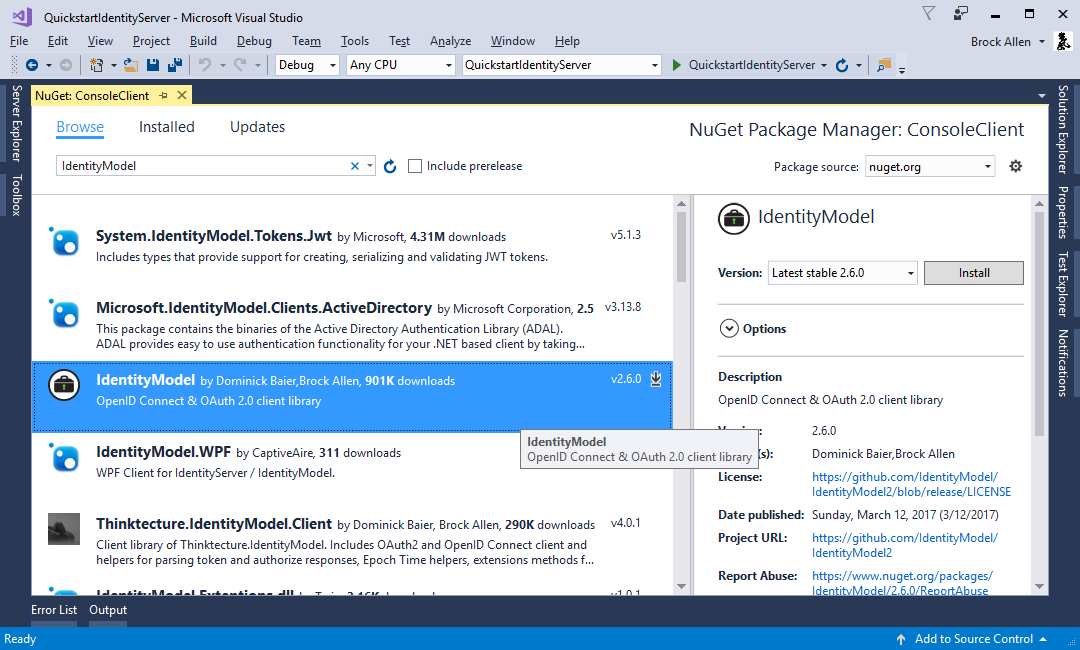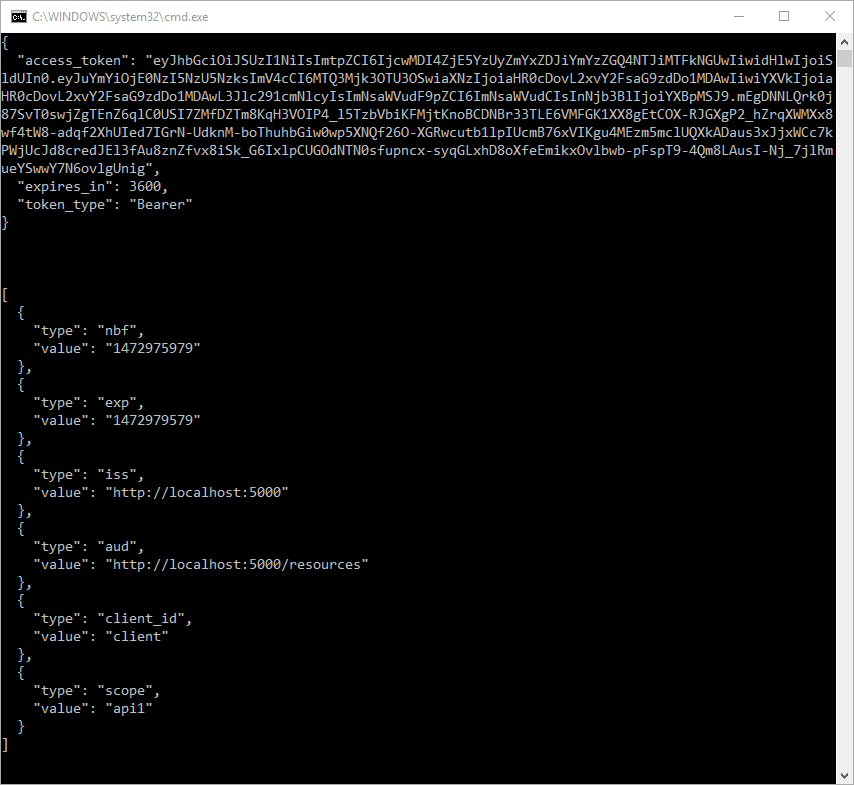IdentityServer4【QuickStart】之使用ClientCredentials流程保护API
使用ClientCredentials流程保护API
这个示例展示了使用IdentityServer中保护APIs的最基本的场景。
在这个场景中我们会定义一个API和一个想要访问它的客户端。客户端会在IdentityServer上面请求一个token,然后使用这个token来访问API。
定义API
在你的系统中,Scopes定义了你想要保护的资源,例如APIs。
因为我们在这个示例中要使用的是内存中的配置,所以你需要做的就是创建一个ApiResource类型的对象,并且设置恰当的属性。
在工程中添加一个Config.cs文件,写入以下代码:
public class Config
{
public static IEnumerable<ApiResource> GetApiResources()
{
return new List<ApiResource>
{
new ApiResource("api1", "my first api")
};
}
}
定义客户端
下一步是定义一个可以访问这个API的客户端。
在这个场景中,客户端与API的交互过程中没有用户的参与,并且会使用client secret这个东西在IdentityServer上进行认证。在Config.cs文件中添加如下代码:
public static IEnumerable<Client> GetClients()
{
return new List<Client>()
{
new Client()
{
ClientId = "firstClient",
ClientSecrets = {new Secret("secret".Sha256())},
AllowedScopes = {"api1"},
AllowedGrantTypes = { GrantType.ClientCredentials }
}
};
}
配置IdentityServer
为了让IdentityServer使用你定义好的Scopes(目前只有API)和客户端,你需要在ConfigureService方法中进行一些配置。下面的代码进行了相关的配置,你的ConfigureServices最终看起来像下面这样:
public void ConfigureServices(IServiceCollection services)
{
services.AddIdentityServer().AddDeveloperSigningCredential()
//配置资源
.AddInMemoryApiResources(Config.GetApiResources())
//配置客户端
.AddInMemoryClients(Config.GetClients());
}
配置好之后你就可以运行了,应用启动之后你可以在浏览器页面上面输入http://localhost:5000/.well-known/openid-configuration(请注意你的端口号),你可以看到如下的内容,这个就是发现文档,discovery document。这个文档会被客户端和API使用,用来下载必要的配置信息。
{
"issuer": "http://localhost:5000",
"jwks_uri": "http://localhost:5000/.well-known/openid-configuration/jwks",
"authorization_endpoint": "http://localhost:5000/connect/authorize",
"token_endpoint": "http://localhost:5000/connect/token",
"userinfo_endpoint": "http://localhost:5000/connect/userinfo",
"end_session_endpoint": "http://localhost:5000/connect/endsession",
"check_session_iframe": "http://localhost:5000/connect/checksession",
"revocation_endpoint": "http://localhost:5000/connect/revocation",
"introspection_endpoint": "http://localhost:5000/connect/introspect",
"frontchannel_logout_supported": true,
"frontchannel_logout_session_supported": true,
"backchannel_logout_supported": true,
"backchannel_logout_session_supported": true,
"scopes_supported": ["api1", "offline_access"],
"claims_supported": [],
"grant_types_supported": ["authorization_code", "client_credentials", "refresh_token", "implicit"],
"response_types_supported": ["code", "token", "id_token", "id_token token", "code id_token", "code token", "code id_token token"],
"response_modes_supported": ["form_post", "query", "fragment"],
"token_endpoint_auth_methods_supported": ["client_secret_basic", "client_secret_post"],
"subject_types_supported": ["public"],
"id_token_signing_alg_values_supported": ["RS256"],
"code_challenge_methods_supported": ["plain", "S256"]
}
添加一个API
下一步,在解决方案中添加一个API。
你可以使用asp.net core web api模板,然后像上面说的那样配置你的API的一些信息,比如使用console作为宿主而不是iis,还要配置好你的应用的端口,最好是将应用的端口固定。你可以在Program类中使用UseUrls扩展方法来进行配置:
public static IWebHostBuilder CreateWebHostBuilder(string[] args) =>
WebHost.CreateDefaultBuilder(args).UseUrls("https://localhost:8001;http://localhost:5001")
.UseStartup<Startup>();
注意UseUrls扩展方法中的配置。在这里由于我使用的是.net core 2.1的运行环境,在asp.net core2.1中默认开启了HTTPs,HTTP上面的请求都会被转发到HTTPs上面。
然后是launchSettings.json的配置:
{
"$schema": "http://json.schemastore.org/launchsettings.json",
"profiles": {
"Api": {
"commandName": "Project",
"launchBrowser": true,
"launchUrl": "api/values",
"applicationUrl": "https://localhost:8001;http://localhost:5001",
"environmentVariables": {
"ASPNETCORE_ENVIRONMENT": "Development"
}
}
}
}
和Identityserver上的配置一样,我删除了关于IIS的配置。
此外你需要在Program中进行配置:
public static IWebHostBuilder CreateWebHostBuilder(string[] args) =>
WebHost.CreateDefaultBuilder(args).UseUrls("http://localhost:5001;https://localhost:8001")
.UseStartup<Startup>();
注意UseUrls扩展方法。
现在解决方案下面有两个工程了:

在API项目上面增加一个Controller:
[Route("identity")]
[Authorize]
public class IdentityController : ControllerBase
{
[HttpGet]
public IActionResult Get()
{
return new JsonResult(from c in User.Claims select new { c.Type, c.Value });
}
}
稍后会使用这个Controller来测试授权请求,同时将claims identity通过api来可视化。
配置
最后一步是将认证服务配置到DI系统中,并将认证中间件添加到管道上面,这些操作将会:
- 校验传入的token以确保他们来自一个受信任的颁发者(一个受信任的IdentityServer)。
- 校验传入的token,确保客户端拥有该API的使用权(或者说拥有这个scope)。
将IdentityServer4.AccessTokenValidation 这个nuget包添加到你的项目中。你可以在程序包管理器上面输入:
install-package identityserver4.accesstokenvalidation来进行安装,记住将默认项目(在程序包管理器上)选择为API项目。
然后更新Startup类,像下面这样:
public class Startup
{
public void ConfigureServices(IServiceCollection services)
{
services.AddMvcCore()
.AddAuthorization()
.AddJsonFormatters(); services.AddAuthentication("Bearer")
.AddIdentityServerAuthentication(options =>
{
options.Authority = "http://localhost:5000";
options.RequireHttpsMetadata = false; options.ApiName = "api1";
});
} public void Configure(IApplicationBuilder app)
{
app.UseAuthentication(); app.UseMvc();
}
}
AddAuthentication 方法将认证服务添加到DI系统中并且将“Bearer”配置成默认的方案(scheme)。AddIdentityServerAuthentication扩展方法 添加了AddAuthentication扩展方法中指定的方案所对应的handler(IdentityServer access token validation handler)。所以这里涉及到一个问题,如果你将AddAuthentication方法中的参数指定为一个随便的字符串,那么你的程序是会出错的,比如说AddAuthentication("shit")。我测试了一下,报了这个错误:System.InvalidOperationException: No authenticationScheme was specified, and there was no DefaultChallengeScheme found.
这就是关于API的东西了,现在它被IdentityServer保护着。
创建客户端
最后是写一个客户端,用来请求access token,然后携带这个acecss token来访问api。我们要创建一个console应用来干这个事儿。
IdentityServer上面的token端点实现了OAuth2.0的相关协议,并且你可以使用原生的HTTP来访问它(比如使用postman)。但是,我们有一个nuget包叫做IdentityModel,这个包封装了相关的协议,使用上也更方便。
在你的解决方案中创建一个console控制台应用程序,然后在程序包管理器中输入install-package identitymodel,这将会安装IdentityModel。或者你可以在nuget控制台通过搜索IdentityModel来安装:

IdentityModel包含了一个可以使用发现文档(就是那个http://localhost:5000/.well-known/openid-configuration的URL指向的一个json文档)的客户端库,在这种方式下你只需要知道基础地址就好(比如http://localhost:5000这个地址,而不用记住http://localhost:5000/.well-known/openid-configuration)。实际的端点地址已经在IdentityModel里面配置好了。
// discover endpoints from metadata
var disco = await DiscoveryClient.GetAsync("http://localhost:5000");
if (disco.IsError)
{
Console.WriteLine(disco.Error);
return;
}
接下来你可以使用TokenClient 类来请求token了。为了初始化它你需要往它的构造函数中传递进去一个token端点地址,客户端id(在identityserver中配置好的)和secret(同样在identityserver中配置好的)。
下一步你可以使用RequestClientCredentialsAsync 方法来获取一个token:
// request token
var tokenClient = new TokenClient(disco.TokenEndpoint, "client", "secret");
var tokenResponse = await tokenClient.RequestClientCredentialsAsync("api1"); if (tokenResponse.IsError)
{
Console.WriteLine(tokenResponse.Error);
return;
} Console.WriteLine(tokenResponse.Json);
可以在jwt.io这个网站上面粘贴获取到的access token来查看详细的信息。
最后要做的就是调用这个API。
通常情况下你要使用HTTP的Authorization头来发送Access token到API。这个是通过SetBearerToken扩展方法来完成的:
// call api
var client = new HttpClient();
client.SetBearerToken(tokenResponse.AccessToken); var response = await client.GetAsync("http://localhost:5001/identity");
if (!response.IsSuccessStatusCode)
{
Console.WriteLine(response.StatusCode);
}
else
{
var content = await response.Content.ReadAsStringAsync();
Console.WriteLine(JArray.Parse(content));
}
之后的输出结果像是下面这样:

默认情况下access token会包含关于scope的claim,还有其他像上面图片上所显示的。
IdentityServer4【QuickStart】之使用ClientCredentials流程保护API的更多相关文章
- 【IdentityServer4文档】- 使用客户端凭据保护 API
使用客户端凭据保护 API quickstart 介绍了使用 IdentityServer 保护 API 的最基本场景. 接下来的场景,我们将定义一个 API 和一个想要访问它的客户端. 客户端将在 ...
- IdentityServer4【QuickStart】之使用ResourceOwnerPassword流程来保护API
使用ResourceOwnerPassword流程来保护API OAuth2.0中的ResourceOwnerPassword授权流程允许一个客户端发送username和password到token服 ...
- IdentityServer4 ASP.NET Core的OpenID Connect OAuth 2.0框架学习保护API
IdentityServer4 ASP.NET Core的OpenID Connect OAuth 2.0框架学习之保护API. 使用IdentityServer4 来实现使用客户端凭据保护ASP.N ...
- IdentityServer4 中文文档 -9- (快速入门)使用客户端凭证保护API
IdentityServer4 中文文档 -9- (快速入门)使用客户端凭证保护API 原文:http://docs.identityserver.io/en/release/quickstarts/ ...
- ASP.NET Core3.1使用IdentityServer4中间件系列随笔(二):创建API项目,配置IdentityServer保护API资源
配套源码:https://gitee.com/jardeng/IdentitySolution 接上一篇<ASP.NET Core3.1使用IdentityServer4中间件系列随笔(一):搭 ...
- asp.net core系列 54 IS4用客户端凭据保护API
一. 概述 本篇开始进入IS4实战学习,从第一个示例开始,该示例是 “使用客户端凭据保护API”,这是使用IdentityServer保护api的最基本场景.该示例涉及到三个项目包括:Identity ...
- 用ASP.NET Core 2.1 建立规范的 REST API -- 保护API和其它
本文介绍如何保护API,无需看前边文章也能明白吧. 预备知识: http://www.cnblogs.com/cgzl/p/9010978.html http://www.cnblogs.com/cg ...
- Identity Server 4 - Hybrid Flow - 保护API资源
这个系列文章介绍的是Identity Server 4 的 Hybrid Flow, 前两篇文章介绍了如何保护MVC客户端, 本文介绍如何保护API资源. 保护MVC客户端的文章: https://w ...
- 第9章 使用客户端凭据保护API - Identity Server 4 中文文档(v1.0.0)
快速入门介绍了使用IdentityServer保护API的最基本方案. 我们将定义一个API和一个想要访问它的客户端. 客户端将通过提供ClientCredentials在IdentityServer ...
随机推荐
- 【转】cookie如何共享到各个浏览器
可以考虑HTML5 localstorage, 点击查看原始尺寸 http://www.cnblogs.com/xiaowei0705/archive/2011/04/19/2021372.html也 ...
- Scrapy 框架 CrawlSpider 全站数据爬取
CrawlSpider 全站数据爬取 创建 crawlSpider 爬虫文件 scrapy genspider -t crawl chouti www.xxx.com import scrapy fr ...
- Java面试题归类
一.Java基础 1. String类为什么是final的. 2. HashMap的源码,实现原理,底层结构. 3. 说说你知道的几个Java集合类:list.set.queue.map实现类咯... ...
- RocketMQ实现事务消息
在RocketMQ4.3.0版本后,开放了事务消息这一特性,对于分布式事务而言,最常说的还是二阶段提交协议,那么RocketMQ的事务消息又是怎么一回事呢,这里主要带着以下几个问题来探究一下Rocke ...
- Python:Day14 集合、函数
浅copy只copy一层 深copy相当于克隆一份 深copy要引入copy,具体如下: import copy wife = copy.copy() #此为浅copy,括号中要加copy的对象,相当 ...
- mysql 行转列 列转行
一.行转列 即将原本同一列下多行的不同内容作为多个字段,输出对应内容. 建表语句 DROP TABLE IF EXISTS tb_score; CREATE TABLE tb_score( id ) ...
- open-falcon之使用mail-provider发邮件(支持smtp SSL协议)
一.首先确定go语言安装环境配置好 1.进入官网下载源码包 https://golang.org/dl/ 2.解压缩,配置环境变量 在/etc/profile最后加上export PATH=$PATH ...
- Feature Extractor[Inception v4]
0. 背景 随着何凯明等人提出的ResNet v1,google这边坐不住了,他们基于inception v3的基础上,引入了残差结构,提出了inception-resnet-v1和inception ...
- Mysql数据库表被锁定处理
1.查进程,查找被锁表的那个进程的ID show processlist; command 为waitting的就是锁住的表,info为执行某条语句的信息,id为进程. 2.kill掉锁表的进程ID ...
- 拉格朗日乘子法(Lagrange Multiplier)和KKT条件
拉格朗日乘子法:对于等式约束的优化问题,求取最优值. KKT条件:对于含有不等式约束的优化问题,求取最优值. 最优化问题分类: (1)无约束优化问题: 常常使用Fermat定理,即求取的导数,然后令其 ...
